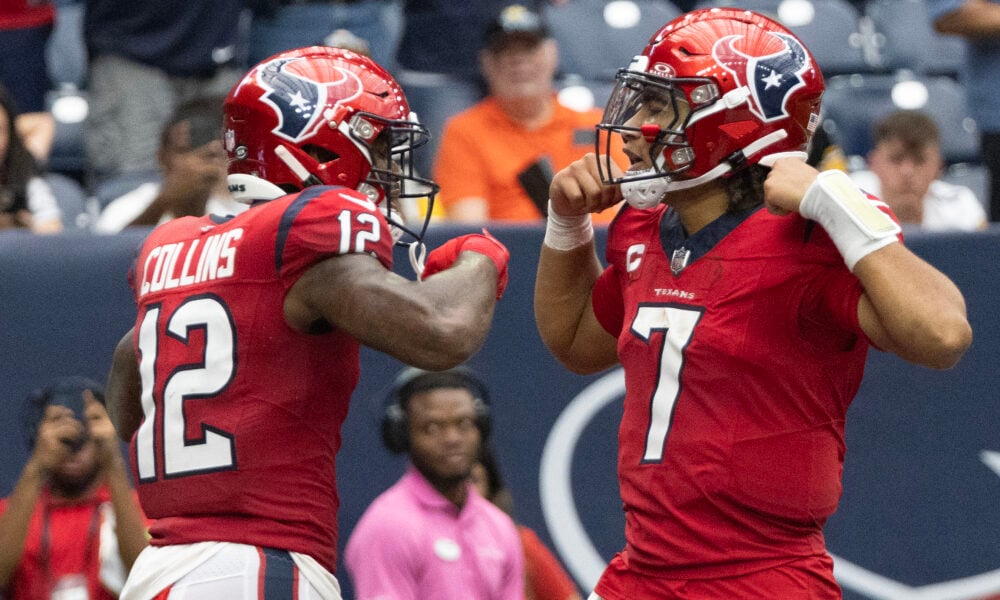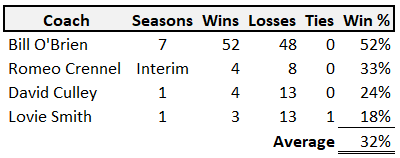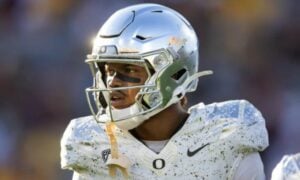Dynasty GAAP Memo: Houston Texans

I am a CPA who fits the typical accountant stereotype. I enjoy writing technical accounting memos, accounting research (yes, it’s a thing), and analyzing the financial statements of a business. In accounting, you often must evaluate qualitative and quantitative factors during complex transactions to forecast future performance. I have found that the outlook and rationale of evaluating business transactions parallels another interest of mine, dynasty fantasy football.
In dynasty, we are given both quantitative factors (athletic scores, draft capital, college production, etc.) and qualitative factors (camp hype, team situation, injury history, etc.) that we must consider and evaluate to derive an estimate or projection of a player. Then, we must take calculated risks based on our team’s overall financial statements (i.e., current roster and league). I could go on and on with accounting-based puns and comparisons, but I think you get it.
I will note that I will write in the form of “accounting memos.” For anyone who has not been exposed, the format is very standard. Each memo will start with the “purpose.” Next, it will outline the applicable “guidance” or accounting literature utilized and supply background. Last will be the analysis and conclusion. The goal is to state the issue and quickly address it. My write-ups will follow this same logic.
To summarize, welcome to “Good at Analyzing Players” or “GAAP”. And yes, this is a play on “Generally Accepted Accounting Principles” and my wife did come up with it.
Purpose
The purpose of this memo is to evaluate the growth strategies implemented and the operating synergies created by the Houston Texans and the dynasty fantasy football impact they have had.
Background
The Houston Texans (“Texans”) is the newest franchise in the NFL. The team was founded in 2002 after the city’s previous franchise, the Houston Oilers, relocated to Nashville to eventually become the Tennessee Titans. Since being founded, the Texans have experienced minor success in the NFL and have the 29th-worst win percentage in the NFL at approximately 43%.
While they have six divisional championships and playoff appearances (2012, 2015, 2016, and 2019), they have zero conference championships or Super Bowls. Since their last playoff appearance, the Texans have cut the face of their franchise in JJ Watt and traded their franchise QB Deshaun Watson, due to multiple HR-related issues (to put it mildly).
The franchise is trending in the correct direction and is currently 2-2 and tied for the lead in the AFC South. One of the biggest surprises thus far in the NFL season is how electric the offense has looked through the first four games. As such, this memo will evaluate the growth strategies implemented by the Texans and the synergies created prior to the 2023 season and evaluate the impacts on player values.
Resources:
- Sleeper: Great interface for looking up historical statistics
- DLF Dynasty Rankings: Best Dynasty Rankings in the Industry
- DLF Average Draft Position (“ADP”) Data: Best resource to gauge current player value. Based upon real Dynasty Startups.
Analysis
The NFL off-season is remarkably like business in the sense that every NFL team is constantly trying to find competitive advantages over one another with various constraints (salary cap, limited draft capital, etc.). In business, this concept is described as growth. Business growth refers to the increase in a company’s size, revenue, market share, and profitability. In the NFL, growth is determined by only one financial metric, wins.
There are multiple growth strategies to implement in both the NFL and business. Inorganic growth is growth from buying other businesses or signing high-price-tag free agents. Organic growth is internal growth the company sees from its operations or developing young NFL draft picks.
The Texans have implored both strategies during the 2023 off-season. They brought in a brand-new coaching staff to implement a new offensive scheme (inorganic growth) and chose to utilize NFL draft picks and continue to develop their other young players (organic growth).
INORGANIC GROWTH (COACHES):
Since Bill O’Brien was fired in 2020 after seven seasons, the Texans’ head coach has been a revolving door. See the table below:

Based upon the 32% average winning percentage above, the Texans went back to the coaching carousel in 2023 and brought in DeMeco Ryans and Bobby Slowik as head coach and offensive coordinator, respectively. Both coaches served various roles on Kyle Shanahan’s staff for the San Francisco 49ers since 2017 prior to joining the Texans. Any fan of the NFL recognizes the Shanahan name as Mike (Kyle’s father) and Kyle’s coaching tree expands all over the NFL. The “Shanahan” offense took the already popular west-coast offense but adopted a zone running game into it. For fantasy managers, these are often the teams that we are targeting. See various head coaching examples and corresponding DLF superflex rankings below:
- Mike McDaniel- Miami Dolphins
- Jaylen Waddle (Overall 13; WR5)
- Tua Tagovailoa (Overall 14; QB8)
- Tyreek Hill (Overall 21, WR9)
- De’Von Achane (Overall 118; RB33) – Too low!
- Kyle Shanahan- San Francisco 49ers
- Christian McCaffrey (Overall 17; RB2)
- Deebo Samuel (Overall 36; WR16)
- Brandon Aiyuk (Overall 55; WR25) – Too low!
- George Kittle (Overall 67; TE4)
- Brock Purdy (Overall 74; QB20) – Too low!
- Matt LaFleur- Green Bay Packers
- Christian Watson (Overall 45; WR19)
- Jordan Love (Overall 62; QB17)
- Aaron Jones (Overall 70; RB15)
- Sean McVay- LA Rams
- Cooper Kupp (Overall 42; WR18)
- Puka Nacua (Overall 71; WR34) – Too low!
- Matthew Stafford (Overall 91; QB23)
- Kyren Williams (Overall 114; RB30) – Too low!
- Robert Saleh- New York Jets
- Garrett Wilson (Overall 16; WR7)
- Breece Hall (Overall 25; RB3)
- Dalvin Cook (Overall 107; RB28) – Too high!
Overall, we know that teams that have utilized inorganic growth and targeted this coaching tree and offensive scheme have yielded fantasy football goodness over and over again.
ORGANIC GROWTH (EXISTING PLAYERS AND NFL DRAFT):
During the 2022 off-season, the Texans averaged 283.5 yards per game, which was good for 31st in the NFL. This would indicate that they did not have a lot of offensive talent on the roster. The Texans did the contrarian thing and doubled down and signed very few NFL free agents on offense. The highlights were Dalton Schultz (one year; $9M), Robert Woods (two years; $15M), and Devin Singletary (one year; $4M). Instead, they continued to invest in the foundation of young players already on the roster and through the draft. See the player-by-player discussion below:
- CJ Stroud (22 years old): Stroud has been nothing short of amazing after being selected second overall in the 2023 NFL Draft. Through four weeks he is the engine that can propel the other players below to fantasy stardom. He is on pace to not only surplus but obliterate NFL rookie passing records.
- Nico Collins (24 years old): Collins was drafted with the 89th pick in the 2021 NFL Draft (third round). He has prototypical size at 6’4”. Through his first two NFL seasons, he has never eclipsed 500 hundred yards in a season. However, this will not continue in 2023 as he has been unlocked by Stroud and the offensive coaching staff. Collins already has 428 yards, which ranks fifth overall in the NFL.
- Tank Dell (23 years old): Dell was drafted at the 69th pick in the 2023 draft (third round). At 5’8” and 163 pounds, Dell is tiny. However, he has proven through four weeks that he might have the traits to be a historical outlier. During college, Dell was a dominant and electric playmaker and picked right up where he left off on Sundays. Thus far, he has two top-24 finishes in PPR and 267 yards.
- Dameon Pierce (23 years old): Pierce was drafted at the 107th pick in the 2022 draft (fourth round). Immediately, he was a featured piece of the putrid Texans offense last season. Even with those constraints (and the accompanying stacked boxes), Pierce was able to rush for an impressive 939 yards in his rookie season in just thirteen games. At 5’ 10” and 218 pounds, Pierce has prototypical size and a physical running style.
These players are what serve as the foundation of the young electric Texans offense. Each of them was drafted in the past three seasons and is the epitome of an organic growth strategy.
BALANCED GROWTH AND OPERATIONAL SYNERGIES:
The Texans have perfectly executed a balanced growth strategy. Balanced growth involves using organic growth to build the company as well as inorganic growth in acquiring other companies to help boost growth. They built the roster through the draft, but brought in new coaches to get the most out of their existing and young assets.
The Texans have created operational synergies between its players and coaches. Synergy is the concept that the value and performance of two companies (players and coaches/offensive scheme/play calling) combined will be greater than the sum of the separate individual parts. Please see various metrics below:
- 368.5 total yards per game (10th overall)
- 281.3 passing yards per game (fourth overall)
- 87.3 rushing yards per game (26th overall)
- 24.0 points per game (15th overall)
The Texans have been comparable to other teams that fantasy managers have targeted and are able to support three top 24 players. For instance, they have had 368.5 yards per game is comparable to the Minnesota Vikings (370.8 yards per game) and Detroit Lions (386.3 yards per game). On these offenses, we have multiple fantasy darlings: Justin Jefferson, Jordan Addison, TJ Hockenson, Keenan Allen, Austin Ekeler, Justin Herbert, etc.
Conclusion
In hindsight, fantasy managers should have seen the Texans’ breakout coming. However, like most of us, I am shocked by the production thus far. I am actively sending offers for the “Big 4” within this offense that I previously mentioned. This coaching staff and the foundations of Stroud, Collins, Dell, and Pierce are here to stay and only continue to climb dynasty rankings. See individual discussion below:
- CJ Stroud: He is currently my QB9 in dynasty ahead of players like Justin Fields, Deshaun Watson, Kyler Murray, and Dak Prescott. The only downside to his game is that he is a prototypical pocket passer and offers little with his legs to limit his upside. In superflex leagues, I have found that you must give a QB to get one, so I would be looking to leverage the players mentioned above as well as draft capital to get Stroud. The 22-year-old is on pace for 5,151 passing yards (the most by a rookie in NFL history).
- Nico Collins: I have seen several analysts that I respect in the industry compare Collins to Tee Higgins and through four weeks, I can see why. He is linked to an ascending QB and has comparable size. DLF has Higgins has a backend WR1 at WR12. I will not go that far quite yet, but I do value him between WR18 and WR20. I would try to leverage older receivers in that range that might be more proven to get Collins. For example, Chris Godwin, Terry McLaurin, Calvin Ridley, Amari Cooper before owners start to pay attention and realize he is on pace for over 1,800 yards.
- Tank Dell: Dell is someone I sold after his first breakout game, and I have been kicking myself ever since. I believe the NFL, and me, might have been “profile” scouting as opposed to watching the player on the field. After Dell and Zay Flowers both put on a show in 2023, I am curious if we will start to see more undersized receivers creep up draft boards. From a value perspective, you might be able to offer a second if he has another quiet week in week five.
- Dameon Pierce: Admittedly, Pierce is the asset that I am the least interested in. However, he is better than his production thus far in 2023. He is currently RB18 on DLF and that seems about right. I would kick the tires with a second and third-round rookie pick and see if I got any takers within my league while he is only averaging 45 rushing yards per game.
“Not winning since 2021…that is not flying for anybody in this building.”
- Dynasty GAAP Memo: 2024 1QB Rookie Mock Draft - April 29, 2024
- Dynasty GAAP Memo: Diontae Johnson - March 29, 2024
- Dynasty GAAP Memo: 2024 Free Agent Wide Receivers and the Christian Kirk Model - March 11, 2024


































































